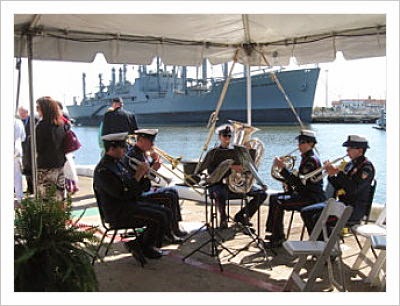 Aisha Jackson, left, and Theresa Cunningham star in Olney Theatre Center's Once On This Island/photo by Stan Barouh
Aisha Jackson, left, and Theresa Cunningham star in Olney Theatre Center's Once On This Island/photo by Stan BarouhThe costuming by Helen Huang In Olney Theatre Center's new production, Once On This Island, threatens to upstage it all.
Skirts made of reflective recycled plastic and tie dye make a splash in shirts, vests, and shorts. Long dresses with handkerchief hemlines, and colored plastic strips follow the female dancers wherever they go.
Blue cellophane becomes a god's robe, silver painted cardboard makes cool royal vestments, and bottle caps decorate head pieces.
Raindrops made of long silver icicles, twittering parrots and umbrellas from colorful plastic bag pieces, and...
OK, enough already about costuming. What's the story?
While members of the audience find their seats before the show starts, the cast drifts in with abandon, casually alighting on stage until Jeff Dorfman's thunder suddenly stops all action with a loud clap, lights go out, flash, and then... silence.
Let the show begin.
The musical is a story about a young girl frightened by a storm who hears the story of Ti Moune, an orphan adopted by an old couple who watches over time as their new child grows into a beautiful young woman. In the eternal love story, set in a nameless Caribbean land (but adapted from Haiti and Jamaica, according to program notes), she falls for Daniel (Eymard Cabling) from across the way whose high place in society endangers their relationship. Ti Moune's ability to weather her station and accept or deny her fate unfolds.
Once stars nine-year-old Ariel Cunningham as a young Ti Moune (alternately played by Shelby Renee Fountain) in her first theatre performance where Ariel easily captures attention whenever she is on stage, looking wonderingly at her playmates and flying around the scenes with the speed and confidence of Peter Pan.
In one excellent transformation Ti Moune dashes off the stage, and returns immediately, several years older in the role continued by the lovely and sincere Aisha Jackson.
To be or not to be an opera, or light opera, since the vocals are all sung and accompanied by marvelous dance (with choreography by Darren Lee), especially by Ms. Jackson in a solo piece where she becomes a twirling jazzerina in a white plastic gown under a spotlight, a scene which contrasts effectively with the darkened stage.
Under the direction of Darius Smith, the six member orchestra plays Stephen Flaherty's Caribbean island music practically non-stop. Lots of samba, an electric keyboard, and percussion dominate. That the singers' harmonies in duets and trios make the best music of the night is no surprise.
An unexpected and well received shadow story provides a glimpse of Haitian history and the French occupation.
The lighting by Marc Hurst is an outstanding aspect of the show, and Milagros Ponce de Leon's scenic designs change the backdrop skies from blue to dark with a full moon and a glowing red whenever the Demon of Death (James T. Lane) makes his appearance. (With an evil, wide smile, gear, and spread feet in a perpetually threatening stance, Lane's devil is the most realistic demon one would never hope to meet.)
Clever designs transform a handheld skateboard with big lights on its bottom into a car which Daniel "drives" fast around the stage. Standing cots with chains become big iron gates which clang shut to keep the peasant girl out of the kingdom.
Once is part of Olney's family series but billed for children over age five. Action and energy keep the young (and old) enthralled throughout, if the story is hard to follow at times. It played on Broadway from 1990 to 1991 and received eight Tony Award nominations.
Jason Loewith, Olney's artistic director, said he chose the play because of its stories of rebirth, forgiveness, and love, especially poignant at this time of year
At the Olney all the characters are African Americans with exception of Mr. Cabling who is Asian.
Others stars are Theresa Cunningham, Fahnlohnee Harris-Tate, Wendell Jordan, Kellee Knighten Hough, Nicholas Ward, Duyen Washington, Stephen Scott Wormley,Jessica M. Johnson, and David Little.
Sesame Street's Alan Muraoka directs.
Lynn Ahrens wrote the books and lyrics, basing her tale on the novella, My Love, My Love, by Trinidad's Rosa Guy (1925-2012) who used The Little Mermaid by Hans Christian Anderson (1805-1810) for foundation.
Herewith, a Helen Hayes nomination:
Outstanding Costume Design, Resident Production: Helen Huang, Once On This Island
What: Once On This Island
When: Now through May 4, 2014 with evening and matinee performances
Where: Olney Theatre Center, 2001 Olney-Sandy Spring Road, Olney, MD 20832
How much: Tickets start at $32.50 with discounts for groups, seniors, military members, and students.
Parking: Abundant, free, and on-site
Duration: About 90 minutes with no intermission
For more information: 301-924-3400
For more area productions and reviews, check out DC Metro Theater Arts.
patricialesli@gmail.com








.jpg)















